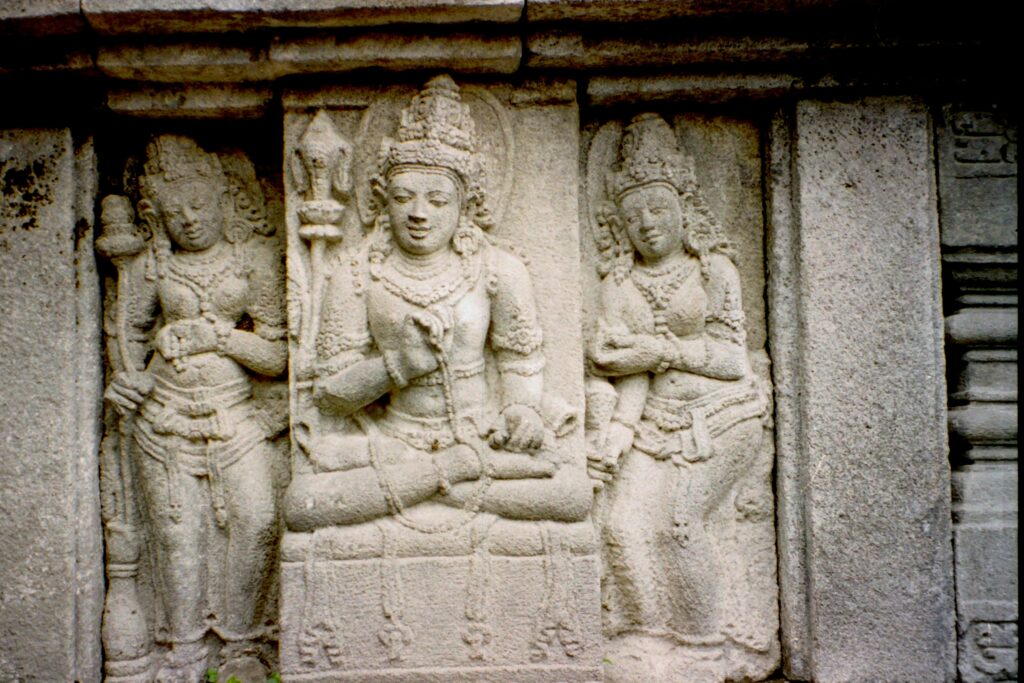
In Hindu mythology, Vahanas—the divine vehicles or mounts of deities—are not simply modes of transport. Each Vahana is a symbolic extension of the god or goddess it serves, reflecting their core attributes, spiritual powers, and cosmic functions. Understanding these symbolic animals offers profound insight into Hindu philosophy and the lessons each deity imparts to the world.
Let’s explore the deeper meanings behind these sacred pairings.
1. Lord Shiva and Nandi (The Bull)
Symbolism:
- Strength & Dharma: Nandi represents unwavering strength and devotion. As Shiva’s constant companion and gatekeeper to Kailash, he symbolizes steadfastness in one’s spiritual path and dedication to duty (Dharma).
- Inner Silence & Meditation: Nandi’s calm posture symbolizes the silent, peaceful mind required for meditation—a quality that reflects Shiva’s nature as the supreme yogi.
- Control Over Desires: The bull’s raw power, when directed inward, represents mastery over one’s senses and primal instincts.
2. Lord Vishnu and Garuda (The Eagle)
Symbolism:
- Speed, Courage & Vigilance: Garuda, the king of birds, represents divine speed and fierce loyalty. His ability to destroy serpents (which often symbolize negative energy) reflects the role of Vishnu as the protector and preserver.
- Mastery of Space: Garuda dominates the sky (Akasha tattva), symbolizing the vast reach of divine grace and wisdom.
- Bearer of the Vedas: In many depictions, Garuda is shown with scriptures, representing the transmission of sacred knowledge.
3. Lord Ganesha and Mushika (The Mouse)
Symbolism:
- Humility and Sharpness: The mouse’s small size and agility signify Ganesha’s ability to access all realms—no obstacle is too small or too large.
- Control Over Ego and Desires: The mouse symbolizes base desires that can gnaw at wisdom. Riding it shows Ganesha’s power to master ego and impulse.
- Presence in the Smallest Details: Mushika’s tiny form reminds us that divinity exists in even the most overlooked corners of life.
4. Goddess Saraswati and Hamsa (The Swan)
Symbolism:
- Wisdom and Discernment: The Hamsa is famed for its mythical ability to separate milk from water—a metaphor for the discriminative intellect (Viveka) that can distinguish truth from illusion.
- Purity and Spiritual Elevation: The swan’s white feathers symbolize purity of thought and speech, central to Saraswati’s domain over learning, music, and the arts.
- Transcendence: As a creature of both air and water, the Hamsa bridges worlds—much like knowledge bridges the earthly and the divine.
5. Goddess Durga and the Lion/Tiger
Symbolism:
- Power and Control: The lion or tiger represents untamed ferocity and brute strength, which Durga masters and rides. She channels this energy toward protecting righteousness.
- Conquest of Evil: In Durga’s mythology, she defeats the buffalo demon Mahishasura—riding a lion into battle, she is the embodiment of divine feminine strength in action.
- Shakti (Divine Energy): Her Vahana reflects the unstoppable force of cosmic energy used to destroy ignorance and uphold cosmic order.
6. Lord Kartikeya (Murugan) and the Peacock
Symbolism:
- Beauty and Pride Conquered: The peacock, a symbol of vanity, becomes a servant to Kartikeya—signifying victory over ego (Ahankara).
- Warrior’s Grace: As the god of war, Kartikeya brings discipline and divine valor, with the peacock highlighting the balance of aesthetic charm and martial might.
- Transmutation of Evil: Peacocks are known to eat snakes, symbolizing the transformation of negative forces into spiritual growth.
7. Goddess Lakshmi and the Owl (Ulooka)
Symbolism:
- Wisdom Amidst Darkness: The nocturnal owl sees clearly even in the dark, symbolizing Lakshmi’s ability to grant inner and outer clarity amidst the illusions of materialism.
- Spiritual Wealth: While Lakshmi is associated with prosperity, the owl reminds us to use wealth wisely, or else risk spiritual blindness.
- Alertness and Independence: The owl’s solitary nature reflects the need for self-reliance and watchfulness in life’s journey.
8. Lord Brahma and the Swan (Hamsa)
Symbolism:
- Creator’s Intelligence: As the god of creation, Brahma’s swan Vahana denotes divine intellect, insight, and the power of discrimination.
- Spiritual Balance: The swan gliding across water without getting wet is symbolic of living in the world without attachment—a key theme in Brahma’s role as creator of the material plane.
- Seven Swans Chariot: In some traditions, Brahma is depicted in a chariot drawn by seven swans—symbolizing the seven levels of consciousness or creative principles.
9. Lord Indra and Airavata (White Elephant)
Symbolism:
- Power, Rain & Royalty: Airavata, the majestic white elephant with multiple tusks, represents authority, strength, and the monsoon rains—under Indra’s control as god of thunder and rain.
- Mythic Origins: Born from the churning of the cosmic ocean (Samudra Manthan), Airavata signifies the sacred outcome of divine effort and celestial collaboration.
- Balance of Power and Grace: Though massive, Airavata is portrayed as gentle, showing that true power lies in controlled strength.
Conclusion
In Hinduism, the relationship between deities and their Vahanas transcends physical depiction—it conveys universal truths, moral lessons, and spiritual guidance. Each Vahana reflects not just the energy of its deity, but also the inner challenges and virtues we must cultivate.
Whether it’s Ganesha mastering ego through a mouse, or Durga riding ferocity itself into battle, these symbolic companions offer profound insights into the human psyche, nature, and the divine. Recognizing the spiritual meanings behind each Vahana allows us to engage more deeply with Hindu teachings and enrich our path toward understanding and inner balance.
Sources & References
- Eck, Diana L. Darsan: Seeing the Divine Image in India
- Kramrisch, Stella. The Hindu Temple
- Coomaraswamy, Ananda K. Hinduism and Buddhism
- Pattanaik, Devdutt. Myth=Mithya: A Handbook of Hindu Mythology
- Britannica: Hindu Deities & Vahanas
- ISKCON and Ramakrishna Mission publications on Hindu iconography
- Shiva Purana, Vishnu Purana, Devi Mahatmya – Primary Scriptural References
About the Author
Written by Sandeep for Pulsewire.in
Sandeep is a cultural writer and researcher with a keen interest in Indian mythology, spiritual symbolism, and ancient wisdom traditions. While not a certified religious scholar, his works are based on meticulous research from primary scriptures and reputed academic sources. The goal is to present timeless insights in a relatable and respectful manner for modern readers.









